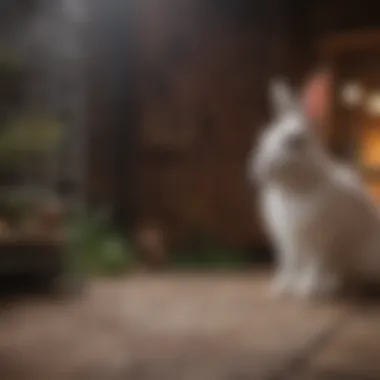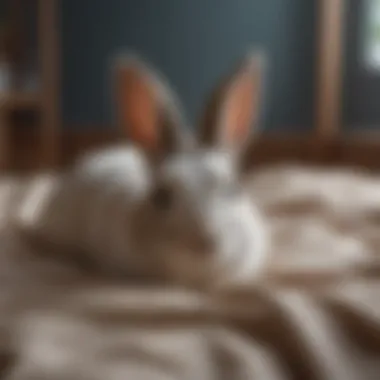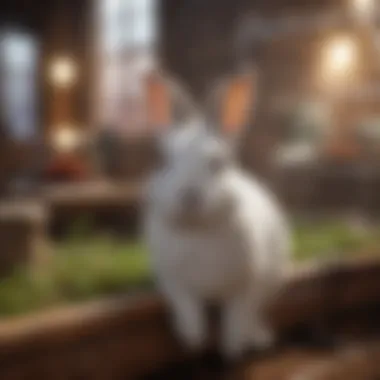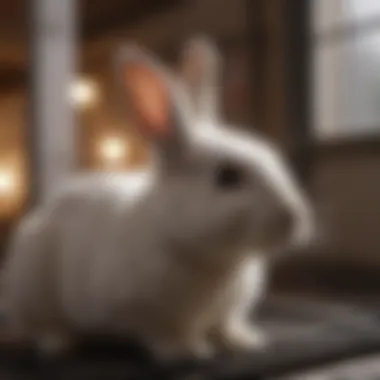Selecting the Best Indoor Bunny Cage: Expert Insights


Intro
When it comes to providing the ideal environment for pet rabbits, selecting the best indoor bunny cage is a decision that should not be taken lightly. The right cage serves as a sanctuary for your furry friend, ensuring comfort, safety, and a sense of security. In this article, we will explore the essential features required for an optimal bunny habitat, examining key aspects such as size, material, and design. Together, we will delve into the importance of a suitable environment, recommendations for specific cages, maintenance practices, and common pitfalls to avoid.
Animal Overview
Common Name and Scientific Classification
The domestic rabbit, scientifically recognized as Oryctolagus cuniculus, has evolved through centuries of selective breeding. This has resulted in various breeds, each with unique traits including size, fur type, and temperament. Domestic rabbits are distinct from their wild counterparts, mainly due to their life in human care.
Physical Characteristics
Rabbits are characterized by their long ears, short tails, and strong hind legs. They typically have a rounded body and a soft fur coat that comes in a variety of colors and patterns. Adult rabbits can vary significantly in size. Breeds like the Flemish Giant can weigh over 14 pounds, while smaller breeds such as the Netherland Dwarf may weigh around 2.5 pounds.
Habitat and Distribution
In the wild, rabbits inhabit meadows, woods, forest edges, grasslands, and other areas with abundant vegetation. However, domestic rabbits live predominantly indoors, making the choice of an indoor cage crucial. It should resemble, as much as possible, their natural habitat, offering space to hop, play, and explore safely.
Behavior and Social Structure
Communication Methods
Rabbits communicate through a variety of vocalizations and body language. They may thump their hind legs to signal danger, or use soft grunts and purrs to express contentment. Understanding these signals can help owners create a more accommodating environment.
Social Hierarchies
Rabbits are inherently social creatures. In the wild, they live in groups that establish a social hierarchy. A pet owner should ideally consider bonding their pet with another rabbit to fulfill its social needs. This can help alleviate loneliness and behavioral issues.
Mating and Reproductive Behavior
While spaying or neutering is recommended for pet rabbits, understanding their natural mating behaviors can be insightful for responsible ownership. Females can give birth to multiple litters each year, which emphasizes the importance of population control among domestic rabbits.
Conservation Status
Current Population Trends
The domestic rabbit poses no conservation threat, yet understanding their wild relatives and their status can be beneficial. Although the European rabbit is widespread, certain species are experiencing population declines due to habitat loss.
Threats and Challenges
Wild rabbits face numerous challenges, including predation and environmental changes. Urban development, agricultural practices, and climate change further threaten their habitats. These dynamics affect the balance of their ecosystems and thus indirectly influence the welfare of domesticated rabbits.
Conservation Efforts and Success Stories
There are several organizations working on habitat preservation for wild rabbit populations. Successful breeding programs and habitat restoration projects have shown promising results, proving that coordinated efforts can lead to positive outcomes for wildlife. Educating pet owners about responsible pet ownership can aid in maintaining rabbit populations in domestic settings and can ultimately contribute to larger wildlife conservation efforts.
Understanding the natural behaviors and needs of rabbits helps ensure that our domesticated friends thrive in our care.
Foreword to Indoor Bunny Cages
Having an indoor bunny presents unique responsibilities and considerations. One significant aspect of bunny ownership is the selection of an appropriate cage. Indoor bunny cages are not merely a confinement space; they dictate the quality of life of your rabbit. When considering what makes the best indoor bunny cage, pet owners must review various factors, ranging from size to design and materials.


It’s crucial to understand the environment that will foster your bunny’s well-being. A well-chosen cage provides a safe haven where your bunny can feel comfortable and secure. Rabbits, being naturally curious and energetic creatures, thrive in spaces that allow for movement and exploration. An inadequate or poorly chosen cage can lead to stress, behavioral issues, or even health problems for your rabbit.
Furthermore, there are benefits to selecting a suitable indoor cage. Such benefits include ease of maintenance and enhanced interaction with your pet. The right cage can also prevent damage to your home, as bunnies may chew on furniture or electrical wires if left to roam unsupervised. The ideal indoor bunny cage will cater to your rabbit’s instinctual needs while complementing your living space.
In the upcoming sections, we will delve deeper into essential considerations regarding your bunny's needs, key features to look for, recommendations for specific cages, and maintenance tips. Each factor plays a pivotal role in ensuring that your rabbit leads a healthy and fulfilling life within your home. As you navigate through this guide, remember that the well-being of your bunny is paramount, and selecting the right cage is a foundational step in responsible pet ownership.
Understanding Your Bunny's Needs
Selecting the right cage for a bunny is not just about dimensions and overall appearance. Understanding the specific needs of your pet directly influences the quality of life it experiences. Bunnies are not merely pets; they are unique creatures with distinct requirements for physical, emotional, and social well-being. Addressing these aspects is pivotal for ensuring they not only survive but thrive in their everyday environment.
The needs of a bunny vary based on its breed, age, and individual personality. However, the cornerstones of bunny care mainly encompass both physical space and social interaction. In this guide, we will discuss these critical elements, ensuring you are informed and prepared to cater to your pet's needs effectively.
Physical Space Requirements
Bunnies require a significant amount of space to move around freely. The minimum cage size for a bunny should ideally be at least four times the length of the rabbit when it is lying down. This will not only provide enough space for the bunny to stretch but will also allow room for litter boxes and toys. A common mistake is to underestimate how much room a bunny will need. For instance, smaller breeds might appear to require less space, but they still benefit from a larger area where they can explore and engage in natural behaviors.
It's also wise to consider the height of the cage. Bunnies are naturally curious and will thrive in environments that offer vertical space. Multi-level cages can be beneficial, allowing them to jump and play. Ensure the structure is sturdy and won’t tip over when a bunny hops around it. The materials used should also not be harmful. Avoid cages made of untreated wood, which can absorb moisture and harbor bacteria.
Social and Behavioral Needs
Rabbits are social animals and thrive when they have interaction. It’s crucial to understand that leaving a bunny alone for extended periods could lead to behavioral issues such as boredom or stress. These behaviors might manifest in destructive tendencies or health-related concerns like fur plucking. Therefore, integrating social aspects into their environment, such as companionship with other rabbits, is beneficial.
When considering the best indoor cage, think about how you can encourage social interaction. This could mean incorporating playtime outside of the cage or planning for time spent together each day. The right cage can facilitate these interactions. For instance, a cage with a large door provides easy access for you to join your bunny in its space.
Encouraging natural behaviors such as digging, chewing, and exploring are essential. Providing various toys and tunnels can fulfill these behavioral needs, making their indoor home an engaging space.
Key Features of a Suitable Indoor Bunny Cage
Selecting the right indoor bunny cage is crucial for the well-being of your rabbit. The right features create a safe and serene environment that fosters their natural instincts. In this section, we will explore essential elements that contribute to a suitable indoor bunny cage, focusing on size, materials, and design considerations.
Size Considerations
The size of the cage is perhaps the most significant feature to consider. Rabbits thrive in spacious environments where they can hop and stretch. An appropriate cage allows bunnies to move around freely, ensuring they remain healthy and active.
A common guideline is the minimum cage length should be at least three times the length of your rabbit. For example, if your rabbit measures 18 inches, the cage should be at least 4.5 feet long. This measurement ensures comfort and reduces stress.
Moreover, vertical space matters too. Adding multiple levels or a tall structure can enhance your bunny's experience. They enjoy exploring different heights, and a spacious cage minimizes destructive behaviors by providing enrichment opportunities.
Materials and Construction
The materials used in the construction of the cage are equally important. Safety and durability are paramount to ensure a bunny's well-being. A good indoor bunny cage often features non-toxic materials like UV-resistant plastic, metal, and untreated wood. Avoid cages made of harmful substances like pressure-treated wood or toxic plastics, as rabbits frequently chew on their surroundings.
Well-constructed cages have sturdy bars that prevent escape while providing good ventilation. The spacing between bars should not exceed 1 inch to ensure small bunnies do not slip through. Furthermore, the base of the cage should be solid, providing a comfortable and secure surface for your pet.
Accessibility and Design
An easily accessible design simplifies interactions between you and your bunny. Cages with large doors or sliding panels allow for effortless access, whether it is for cleaning or handling your pet. Additionally, consider designs that facilitate easy setup for playtime outside the cage.
The design should also include a litter box area separate from their sleeping and eating areas to keep the cage tidy. Many rabbits prefer an organized space. Some cages come equipped with removable trays, making cleaning hassle-free.
Design elements such as ramps, tunnels, and hideaways contribute to stimulation and comfort. These features mimic a rabbit's natural environment, enabling them to forage and play, thus reducing feelings of confinement.
Combining the right size, materials, and design features helps ensure your bunny's happiness and health. A thoughtful selection supports their instinctual needs while enhancing your living space.


Understanding these key features assists in selecting a suitable indoor bunny cage. A thoughtful approach helps cater to your rabbit’s physical and behavioral needs, promoting a happier and healthier pet.
Top Indoor Bunny Cage Recommendations
Selecting the right indoor bunny cage is a crucial task for any rabbit owner. This section presents specific recommendations based on the different living arrangements you may have. Each category considers factors such as size, breed, and habitat complexity. By understanding these recommendations, you can create a nurturing environment and enhance the quality of life for your furry companion.
Best for Small Spaces
For those who live in apartments or smaller homes, finding a suitable indoor cage is essential. A small cage doesn't mean compromising on comfort or safety. The MidWest Homes for Pets Deluxe Critter Nation is an excellent choice. This cage offers both vertical and horizontal space, allowing your bunny to hop around comfortably. It features multiple access points, making it easier to care for your pet.
- Size: Approximately 36 inches long, 24 inches wide and 62 inches tall.
- Accessibility: Multiple doors for quick access.
- Construction: Durable wire with solid plastic base.
This cage is designed specifically for small spaces, thus it fits well in tight corners while still providing ample room for your bunny to roam. Remember to incorporate hides and toys to enrich the environment.
Best for Larger Breeds
Larger bunnies have unique needs, and their cages must accommodate their size adequately. The Ferplast Krolik 140 is an excellent option for larger breeds like Flemish Giants or New Zealand rabbits. Its vast space provides enough room for play and comfort.
- Dimensions: 55.1 inches in length and 23.6 inches in width.
- Material: Galvanized wire and plastic base to prevent wear and tear.
- Design: Comes with an elevated platform and a spacious living area.
With a solid base and high sides, this cage also ensures your rabbit feels secure. Make sure to provide various enrichment items, as larger breeds can get bored without adequate stimulation.
Best Multi-Level Cages
For those who want to maximize vertical space and provide a more dynamic environment, The PawHut 2-Level Rabbit Cage offers an exciting solution. It encourages natural behaviors and movement.
- Structure: Two levels with ramps that allow free movement.
- Size: 48 inches long, 23.5 inches wide, and 41.5 inches tall.
- Features: Slide-out tray for ease of cleaning and multiple access doors.
Multi-level cages like this one offer your bunny a chance to explore while giving them a secured area to rest. Ensure there are no gaps where your bunny could escape, and provide different bedding options across levels for comfort.
Choosing the right cage based on your living arrangement and your bunny's needs is a key step to ensuring a happy and healthy life for your pet.
Bunny-Proofing the Cage Environment
Bunny-proofing the cage environment is a crucial aspect that cannot be overlooked when considering the well-being of your pet rabbit. Creating a safe habitat is essential for preventing injuries and ensuring comfort. Given rabbits' curious and active nature, they may chew or dig at anything they can reach. Therefore, understanding what needs to be secured or modified is vital.
Identifying Hazardous Areas
Begin by identifying areas within the cage that could pose a risk. These can include:
- Wires and Cords: Bunnies are notorious for chewing on electrical cords, which can lead to dangerous situations. Use cord protectors or relocate wires out of reach.
- Toxic Plants: If you place plants in or near the cage, confirm they are safe for rabbits. Some common houseplants, like philodendrons, are toxic.
- Small Objects: Avoid including small toys or items that can be swallowed. Choose larger, durable toys made specifically for rabbits.
Creating a hazard-free environment promotes a sense of security for your rabbit, allowing them to explore safely.
Safe Materials for Bunnies
When it comes to materials in the cage, opt for those that enhance safety and comfort.
- Wood: Utilize untreated wooden items. They can be chewed on safely and provide an engaging texture for your rabbit.
- Plastic: Ensure any plastic items are free from harmful chemicals. Look for BPA-free options to prevent possible health risks.
- Bedding Materials: Select non-toxic bedding materials such as paper-based or grass hay, which are safe for consumption if ingested. Avoid cedar or pine shavings as they can be harmful.
Establishing a bunny-proof environment requires careful consideration of what to include and what to eliminate from the cage. Ensuring safety is an ongoing process, as rabbits are playful and may find new ways to interact with their surroundings.
Maintaining a Clean and Comfortable Cage


Maintaining a clean and comfortable environment for your indoor bunny is essential for the health and well-being of your pet. A clean cage helps prevent illness, reduces unpleasant odors, and creates a pleasant space for your bunny. Knowing how to manage cleanliness is just as important as choosing the right cage. Regular cleaning fosters a healthier habitat and encourages positive behaviors in your rabbit.
Cleaning Routines
A consistent cleaning routine is key. Establishing a schedule helps ensure you do not overlook important tasks. Here are some essential steps to consider:
- Daily Spot Cleaning: Remove any feces and wet bedding each day. This prevents the buildup of bacteria, which can lead to health issues for your bunny.
- Weekly Deep Cleaning: At least once a week, provide a thorough clean. This includes removing all bedding, washing the cage with a pet-safe cleaner, and rinsing it well to avoid residue.
- Check Toys and Accessories: Regularly inspect toys and accessories for wear and tear. Replace any items that may pose a danger to your bunny.
Having a consistent cleaning schedule not only promotes hygiene, but also gives you an opportunity to observe your bunny’s behavior and health closely.
Bedding Material Options
Choosing the right bedding is crucial. The material can affect both cleanliness and comfort. Options vary based on absorbency, comfort, and safety:
- Aspen Shavings: A good choice for its absorbent properties and low dust levels. It is also relatively affordable and can often be found easily.
- Paper-Based Bedding: This is soft and highly absorbent. It is an excellent choice for bunnies with respiratory issues, as it produces little dust.
- Timothy Hay: While not typically used as bedding, it serves a dual purpose. It can provide comfort and becomes a treat for your bunny. However, it requires more frequent changes as it can mold if wet.
When choosing bedding, consider what your bunny prefers. Comfort impacts your bunny’s stress level and overall happiness.
Common Mistakes to Avoid in Cage Selection
When selecting a cage for your indoor bunny, it is crucial to be aware of common missteps that can lead to an unsuitable environment. These mistakes can potentially harm your rabbit's well-being and inhibit its natural behaviors. By recognizing these pitfalls, you can create a more enriching habitat for your pet. In this section, we will detail two significant mistakes: underestimating size needs and ignoring ventilation issues.
Underestimating Size Needs
One of the primary errors is not providing enough space. Rabbits require room to move freely, stretch out, and explore. A small cage may limit your bunny's physical activities, which can lead to obesity and stress. It's important to account for the rabbit's adult size. For example, a dwarf breed may need a cage that is at least 24 inches long and 24 inches wide, while larger breeds might need a cage that exceeds 36 inches in length.
Additionally, consider your bunny's behavior. Rabbits are known to hop, play, and dig. A cage that feels cramped can cause anxiety. It also restricts their ability to express natural behaviors. Therefore, choosing a larger cage is essential for a healthy and fulfilling life.
Here are a few considerations to assist in deciding on the right size:
- Assess the breed of your rabbit.
- Ensure there is enough room for bedding, food, and a litter box.
- If possible, allow for additional space for toys and hiding spots for mental stimulation.
A spacious environment can enhance your rabbit's life and wellbeing significantly.
Ignoring Ventilation Issues
Ventilation is another aspect that often gets overlooked. Poor airflow can lead to the accumulation of odors, humidity, and bacteria. This environment can be detrimental to your bunny's health, leading to respiratory issues. It also can encourage the growth of mold and mildew, which are harmful to both rabbits and their owners.
When evaluating a cage for your rabbit, ensure that it allows for adequate airflow. Look for cages with wire exteriors or mesh panels. These features can provide sufficient ventilation while still protecting your bunny. Avoid cages that completely enclose the rabbit with solid materials, as this can trap heat and moisture.
To check ventilation potential consider:
- The material of the cage.
- The layout of any bedding and accessories.
- Placement of the cage in your home, ensuring it is not in overly cramped or stuffy locations.
By paying attention to these common mistakes, you can select a cage that meets your bunny's needs more effectively. A proper understanding of size and ventilation will contribute to a happier and healthier indoor environment for your pet.
End: Creating the Ideal Indoor Environment
Creating an ideal indoor environment for your rabbit is crucial for their overall well-being. Bunnies are sensitive creatures that need proper attention to thrive. This section emphasizes the significance of a well-chosen cage and a comfortable habitat.
A suitable cage serves as a safe haven for your bunny. Not just a space to sleep, it should accommodate their physical and emotional needs. The right indoor cage will promote exercise, social interaction, and relaxation. This directly impacts their health and happiness.
Consider the following elements when establishing an ideal indoor environment:
- Space: Ensure the cage is large enough for your bunny to move and play. Adequate space reduces stress and prevents boredom.
- Location: Place the cage in a quiet area, away from direct sunlight and inclement weather, while still allowing for family interaction.
- Enrichment: Include toys, tunnels, and other engaging materials. Mental stimulation is essential for bunnies to maintain health.
- Cleanliness: Regular cleaning is vital. A clean cage impacts your bunny's health, as they are prone to certain illnesses if their environment is not well-maintained.
There are substantial benefits to focusing on the ideal indoor environment for your rabbit. It leads to a healthier lifestyle, reduces anxiety, and fosters a stronger bond between pet and owner. When bunnies feel secure in their environment, their behavior tends to become more predictable and calm.
"A rabbit’s environment must reflect its natural instincts. An enriching habitat is key for mental well-being."







